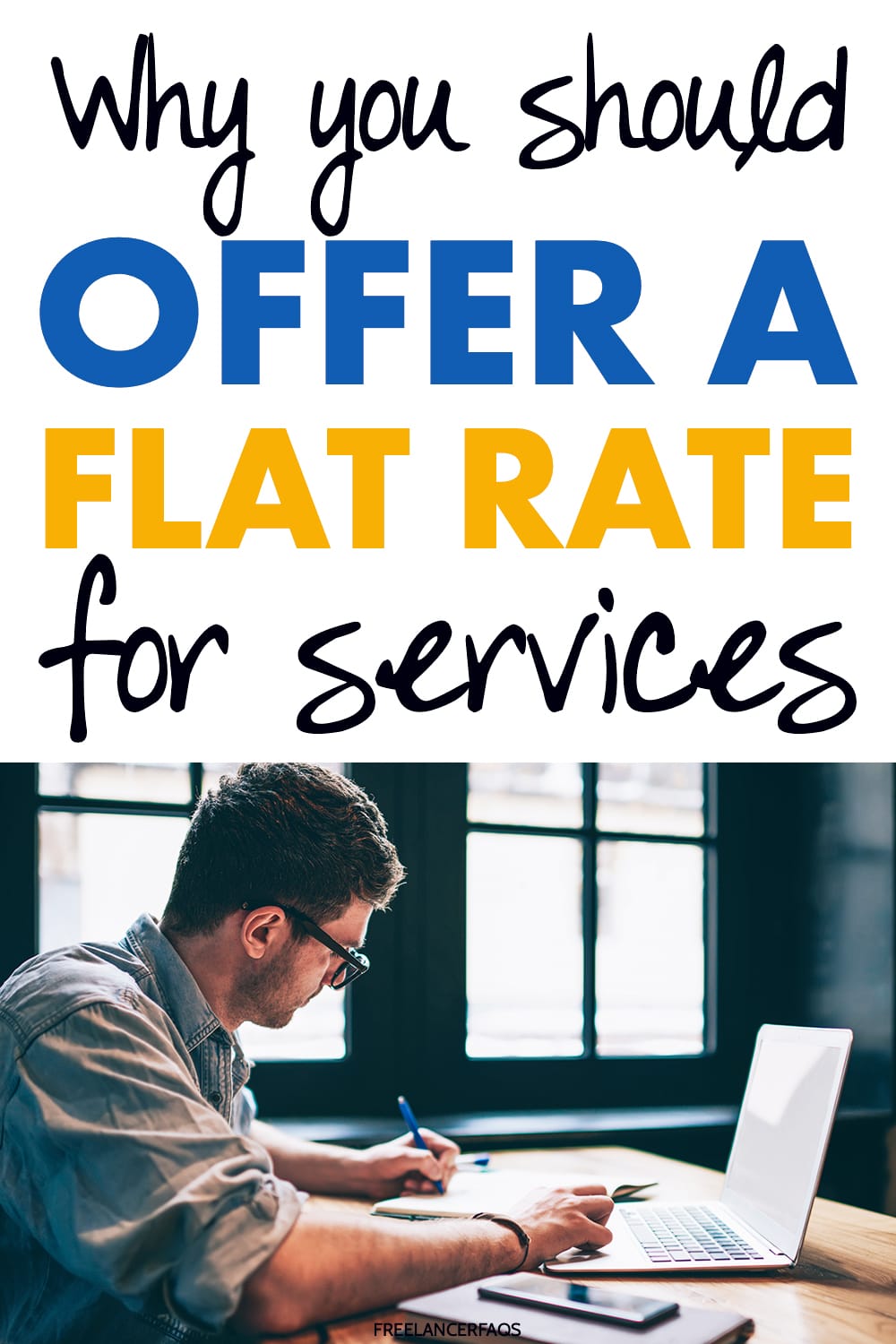When I first started freelance writing, I priced my services all kinds of ways.
If the client wanted me to work hourly, I did that. If they wanted me to charge per word, I did that. In the beginning, I was only concerned with pleasing clients.

When I first started freelance writing, I priced my services all kinds of ways.
Really, I should have been pricing my services in a way that benefitted me.
Then after about a year of freelancing, I started experimenting with different ways to charge for my services. I wanted to know which earned me more for my time: hourly work or flat rate fees?
Here’s what I found out:
Why Hourly Work Sucks
I’ve worked a lot of hourly freelance jobs over the years. Here are the main reasons I don’t think it’s a good way to price your freelance services:
You need to charge more, but can’t
Getting clients to pay you a good hourly rate is challenging. Freelancing isn’t just like an hourly desk job that comes with benefits like medical care.
When setting your rates, you have to take into consideration extra expenses, like your home office, WIFI, medical insurance, etc.
As a freelancer, you should charge a higher rate to compensate for these things.
But most clients don’t understand that. They’re not willing to pay a freelancer more than they pay their accountant or legal counsel. So it’s really hard to find a good hourly wage as a freelancer.
There’s no guarantee you’ll always be paid for your time
One good thing about working hourly is that if a project ends up taking more time than you expected, you’ll get paid for the extra investment. But hourly work doesn’t always protect you from this problem. On lots of job sites, for example, clients will hire you at an hourly rate and “authorize” you to spend a maximum of X number of hours on a project.
If you end up working beyond this limit, there’s no guarantee they’ll pay you.
You can only earn so much with hourly work
Doing hourly work also comes with some inherent limitations to how much you can earn. Say you’re working a 40-hour week at $50/hour. In this hypothetical situation, you could earn $2,000/week. But no freelancer spends 100% of their work week actually on client projects.
There’s business maintenance, pitching, marketing and other tasks that take up a lot of your time. So you’re never earning that much.
On the other hand, say you do have a completely full schedule with client work. You have no time to market your business and no room in your schedule to add on new clients. How are you supposed to scale your income at this point?
You can raise your rates on your current clients, but that’s only acceptable once (or maybe twice) a year. When your income is tied to your time investment, scaling your business will always be a challenge.

Why Flat Rate Services Rule
Now you know why hourly work is no good (in my opinion). Next you should see why flat rate services are really the way to go:
You can earn WAY more per hour
When I first started out, I regularly quoted clients a flat rate price for a project, thinking it would take me 4 hours, then in reality it took me 10. That was frustrating and a good learning experience, to say the least.
So for a long time I thought flat rate services (e.g. charging $500 for an article) wasn’t worth it.
Then I started using a software tool to keep track of how much time I was spending on client projects and how much they were paying me. That’s when I discovered that with some of my flat rate clients, I was earning several hundred dollars per hour.
To illustrate, here are examples of time investment and earnings from some of my previous clients:
- Client A paid me $50/hour to write articles that took me 2 hours to complete. That’s $100 per article. Horrible pay.
- Client B paid me a flat rate of $440 to write articles that also took me 2 hours to complete. That comes out to $220/hour! Amazing!
This realization really shocked me. Even if I increased my rates on client A to $70/hour, that still wouldn’t earn me anywhere near as much money for my time investment.
Your expertise and productivity benefit you
I’ll admit that I worked for Client B for a long time and when I first started out, I couldn’t bust out an article in 2 hours.
I had to spend a lot more time researching the topic, citing sources, adjusting my tone to their blog, etc. But after a while I got much more efficient at those things.
And since I charged a flat rate price, it was to my advantage.
Think about how it works with an hourly job. Say in the beginning it takes you 4 hours to research and write an article.
But over time you become an expert on the topic, then you can finish an article in just a couple hours. Who benefits from your expertise and speed? The client.
Working quickly on an hourly job means you earn less money, plain and simple.
After I made these realizations myself I basically stopped working hourly altogether. The better I got at writing the more I could charge and the more I could benefit from my time investment. The truth is, most clients don’t have any idea how long it takes you to complete an assignment.
A $440 flat fee for a blog post can sound like a reasonable price. $220/hour for freelance services? Forget it.
You can earn even more with package services
Another huge advantage of offering flat rate pricing is that you can create package deals to earn even more from your clients.
Package services are when you offer a variety of related services bundled together with a single price tag.
As a writer, for example, a lot of clients ask me for help with things like keyword research, in-post graphics design, formatting for the web, WordPress upload, etc.
Instead of charging a separate rate for each task, I bundle them all together and offer a grand total price for writing + whatever else they need.
Even if you’re charging a much higher price than for an article alone, lots of clients will go for it.
Because otherwise they’d have to hire each of these services separately. They’d need an SEO expert, graphics designer, blog manager, etc.
That would cost way more money than just having you take care of these tasks for them at whatever price you set.
Let’s go back to the 2-hour article example. Say a client wants me to perform keyword research and upload to WordPress in addition to writing.
I quote them a package price of $700 total. The total job takes me 3 hours to complete. Now I’m up to $233/hour, and I’m being paid more overall!
The Bottom Line
I’m not saying you should never work hourly. Most of the gigs on jobs sites these days are hourly.
And doing some hourly work is a great way to get exposure in your niche and help you learn how long it takes you to complete tasks.
This can help inform how you set your flat rate services down the road.
There are lots of ways to grow your freelance income by changing your pricing strategy.
My advice is that you pay attention to what kind of extra tasks your clients regularly ask you to help with as a freelancer. Bundle these into package services that you can highlight on your website or rate card.
Because in the long run, flat rate fees and package services are huge money-earners for most freelancers.



Leave a Reply